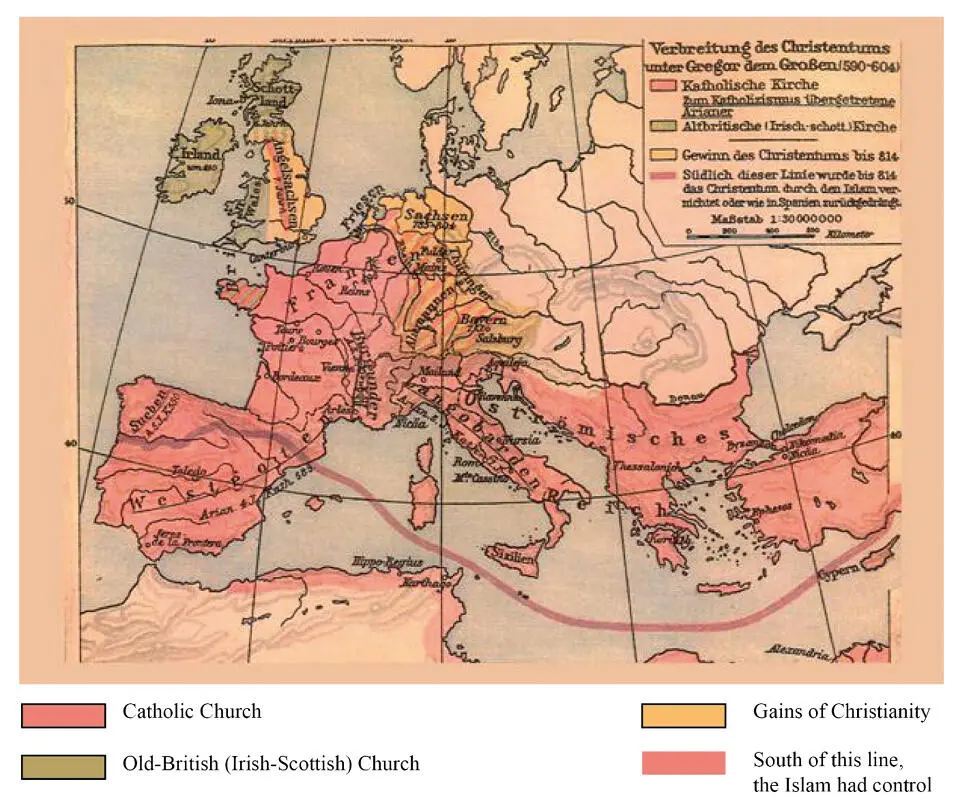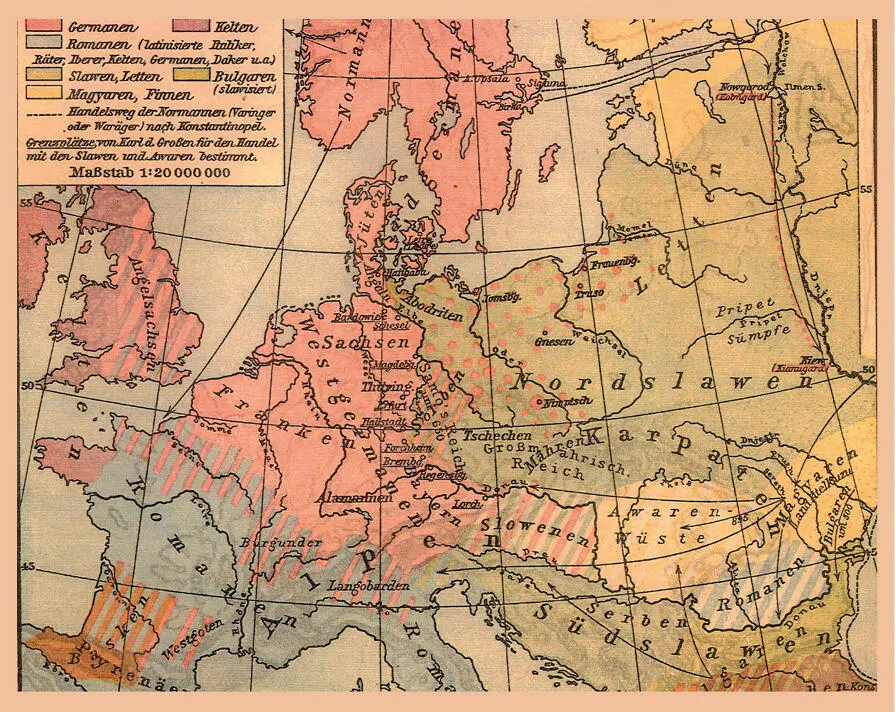Later on, the three castles were re-erected: Ravensburg gave the surrounding area its name and was home to ge-nerations of counts. Iburg became the summer residence of the bishop of Osnabrück.
Tecklenburg, finally, was home to generations of so called “Reichsfreie” Counts (reichsfrei = nobility status throughout the Middle-Ages, comparable to the baronage) until the county became part of Prussia in 1707 A.D.
But for the Saxons all resistance was eventually in vain. The battle at Lübbecke in 775 A.D. and at Süntel, as well as Karl’s retaliatory strike in 782 A.D. at Verden/Aller, brought Wittekind’s stampede to an end and led to his subjugation in 785 A.D. After that victory in Aller, Karl ordered a severe punishment against the Saxons, where on a single day about4500 Saxon noblemen were slaughtered, and Wittekind:
Quote: “Bowed his neck into the baptismal font”.
In a three day battle, the Saxons under Wittekind were defeated in the midst of their stronghold near Osnabrück. From here, near the battle field along the Hase River, the conversion of the Saxons to Christianity took place.
And as such, the bishopric of Osnabrück was founded in 785 AD.
King Karl, using sound military considerations, appointed ecclesiastical satraps (military clergymen).
The bishops in Osnabrück as well as in other Saxonian centers had only moderate success in getting along with the local people.
To them, the christening, the Roman prayer book and the Franconian culture were distinctly strange.
But after more than thirty years of struggling with the Saxons, Charlemagne (King Karl) had achieved his goal of spreading Christianity throughout his empire.
(See fig.:#12 and #13)
Christianity after Charlemagne
Around (814 A.D.)
(fig.:#12)

Population in Central Europe around 900 A.D.
(fig.: # 13)

Charlemagne Establishes the Tithe in the Area
When Charlemagne assembled his Court at Lippspringe (around 782 A.D.), he issued harsh statutes against the Saxons: the “Capitulatio de partibus Saxonae”. Only two from 14 laws are quoted here:
---“Everyone is to be doomed (beheaded) who clings to his old believe, and who conspires against Christians, and who persecutes or scoffs at ecclesiastical establishments”. ---
--- “The order is, that every parish is to receive 2 “Hufe” (= approx. 50 acres) of land, the services of farm hands and maids, and the tenth (tithe) of any income”. ---
Every one of these laws ended with: “morte moriatur” (be doomed).
Now, the foundation had been laid, the way was open for the German people to move into the Middle-Ages, a very Christian, but also a very bloody period.
On the topic of tithing, even Alconius Alkuin, a prominent friend of and advisor to Charlemagne in all matters of religion, lamented in a letter:
“Did the Apostles, when Christ sent them to teach Christianity to the whole world, ask for the tithe? Possibly, the tithe is necessary, how-ever, its forfeiture is insignificant compared to the loss in Faith”.
It was Charlemagne policy to divide his conquests into counties, each governed by a bishop or archbishop. The bishopric of Osnabrück with bishop Wiho was the first in the land of the Saxons.
It can be assumed that the erection of local chapels outside of Osnabrück was started shortly thereafter: one in the west, the West-Chapel (= Westerkappeln), and one in the east, the East-Chapel (= Osterkappeln). Charlema-gne also issued the Franconian-Land-Order and installed regional administrators, named Gaugrafen = district-counts). He named the place“Ossenbrügge”, where – as the saying goes - the Franconian-Christian army, while struggling with the Saxons, managed to cross the river Hase with the help of an ox which showed them a ford (Furt) to cross the waters.
The place was secured with a wall and a ditch and given the Franconian law. That’s how “Ossenbrügge” became modern day “Osnabrück”.
He installed a bishop and gave him the tithe on fields, forests and all pastures around.
The annual contribution enforced and delivered by all the farms in our territory to the clergy and/or secular ruler
runs like a red thread throughout the Middle-Ages till the final collapse of the “Holy Roman Empire of German Nation” around 1806 A.D.
These miscellaneous taxes are historically verified over the following centuries, and are subject to further consi-derations later on.
Charlemagne and later his sons had established a pattern to give grants to their meritorious military leaders and other deserving confidents in form of estates and land as well as special privileges over assets and life of their subjects. This was considered in part a gratitude as well as commitment for duty in the future.
Initially, those persons concerned, the honoured and so named counts and dukes, had to use their entrusted power in the name of the emperor or king. At the same time, the bishops were supposed to be only responsible for the religious/clerical matters and questions of morality.
However, the Imperial Court or his herolds had to intervene rather regularly in those many disputes and struggles for power between the clerical (bishops) and secular (dukes, counts) authorities. Thus, within this kind of medley, the initially granted privileges became over the following centuries hereditary.
Although Charlemagne had according to the Franconian Statutes not formerly renounced private property per se, the handwriting of history had taken a somewhat other turn:
Another pillar of Feudalism had established itself,
Resulting in a two class-society that lasted nearly 1000 years and put its face onto the history of Europe:
A society of those with power and the might of control – and the remaining others,
who had to live their every-day-life or just endure it.
These were the centuries where the structures of the secular power concoction and the clerical interests found op-portunities and time to solidify themselves to last way into the Renaissance with different results to be classified as good and bad:
The “good” – part, beginning with the 15th century, was especially the rapid development of civilization, the discovery of the world-wide globe, the letter-printing, and above all the new dimensions in art and philosophy.
The “bad”- part were the many skirmishes of those many small potentates, the rule of the mercenaries, and those many courtiers serving the sovereigns to show their glitter and pomp to the world.
And yet, despite those contradicting conditions, this period was nevertheless a deeply religious epoch which included both, Martin Luther with the Bible as well as Savonarola burning pictures on Italian market places.
What then followed, after 1500 A.D., can be confidently called the “bloody Renaissance”. It was not the idealistic humanity anymore that dominated, but rather the fanned fear of Hell and Devil, growing into a militant intolerance against any deflection in religion and believe and ending in multiple religious conflicts throughout Europe. And as if this wasn’t already enough, there were epidemic events like the “Black Plague”, also called the “Black Death”, which swept the world in the 14th century, reaching Europe at its peak around 1350 A.D. and reducing the population there by one third. Two other events, even more profound, caused thereafter dramatic spititual, economic and social changes:
Читать дальше














